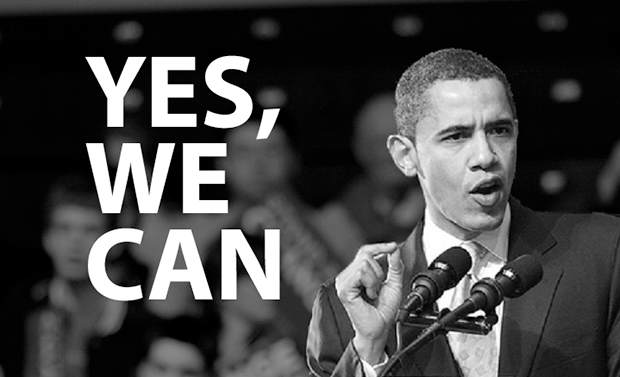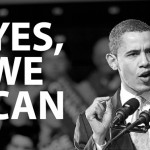
“Stop the boats”
“Axe the tax”
“Yes we can”
What do Tony Abbott and Barrack Obama have in common? “Stop the boats”, “Axe the tax” and “Yes we can” are prominent three word slogans that sent clear messages to their intended audiences, and helped both men secure election victories.
So, can we use three word slogans to communicate change in our workplace? The obvious answer is yes. The qualified answer is yes, but be cautious of falling into the trap of management by slogans.
Why use three word slogans at work?
The power of three word slogans is well known in advertising.
Think Coke: “Coke is it!” or Jaguar: “Grace… Space… Pace” or Marks and Spencer: “Quality. Value. Service” and you’ll see what I mean.
In a business world with internal projects, a three word slogan can be quite powerful.
When individuals consider change and whether to adopt the new behaviours required from the change or adapt to the new environment a change brings, their intention – as the precursor of human behaviour – is guided by three considerations: behavioural beliefs, normative beliefs and control beliefs (Ajzen, 1985). In their respective aggregates, behavioural beliefs produce a favourable or unfavourable attitude toward the behaviour; normative beliefs result in subjective norms; and control beliefs give rise to perceived behavioural controls. Actual control and intention form the basis of actual behaviour.
Behavioural beliefs are heavily influenced in the strength of opinion they hold. For example, one person might strongly believe that smoking will have a seriously detrimental effect on their health. Another person may only slightly believe it, or not believe it at all. The strength of each belief determines how prominent that belief is in affecting the individual’s behaviour.
At first, the strength of opinion that an individual holds is dependent on whether they have heard about and understand the change. If they have not heard about it, then your effort to build a strongly held positive opinion is dead in the water before you start.
In a world where internal and external communications are increasingly social media driven, and where people have a louder voice than ever before, using a proper 3-word slogan can help spread your communication for you.
Using slogans, whether three words or not, can be a legitimate way of raising awareness and helping establish strong positive opinions in people’s minds. However, the land of unintended consequences is not very far away when we fall into the trap of managing by slogans.
We manage by slogans when we spend time on the words and resources on communicating them, but don’t build the infrastructure and cultural environment to enable people to carry out the intent of our inspiring words.
Managing by slogans takes two forms.
Crossed wires
When leaders do not do their homework and create a slogan that enthuses others to fix something that is not broken, or miss the point and not fix what is broken, the well of disbelief amongst employees is deep, but unseen at first. However, over time, it manifests itself by unintended consequences including, but not limited to:
- Lower retention rates as employees leave for pastures not necessarily greener, but where there is greater congruence between the issues affecting an organisation, its employees and its customers, and the actions taken. Department stores in Australia are likely to have seen this in spades as failed internal initiatives to fix what’s “wrong” failed repeatedly in the last ten years.
- Poor performance as employees can see what their purpose should be in their role, but are continually side tracked on to the mantra of the day. Government “efficiency dividends” which are manifested by cutting services rather than increasing levels of automation, providing work flow capability or devolving authority and accountability in equal measure, for example.
Examples in the business context include slogans associated with cost cutting, which ignore the possibility of improving sales or sales margins, or the reverse. Or slogans which espouse the need to improve sales, when customer service is atrocious. Or where organisations miss the disruptive technology boat and form slogans to get people to work harder or even smarter (think Kodak).
Examples in a government context which have an impact on all of society include “low debt”, when debt is already low and the issue is revenue levels, or “tough on crime” whilst ignoring recidivism rates.
If we are going to use powerful words to make people take notice, then we had better make sure we have identified the real problem to communicate.
Hollow words
Creating a powerful slogan and accompanying themes of colours, fonts and logos as a communication tool must be matched by action on the ground. Otherwise, you inevitability create cynicism about the change.
As an example, creating a slogan around “Get it right first time” in a manufacturing organisation without holding discussions with the workforce to understand what is ‘right’, and without putting in place the tools to measure the current state and processes to continuously improve, the slogan-based campaign is doomed to fail in a volley of sarcastic remarks from the workforce.
Using a slogan to pithily communicate the core of what we believe or what we want to happen carries the responsibility of matching our own rhetoric with our own action.
It is simply not good enough to dream up the inspiring words and not create – or be seen to be working to create – the supporting structure of policies, processes and procedures and investment in training and equipment to make the slogan an achievable reality for the staff you lead.
Avoiding management by slogans
Using slogans and other related collateral to communicate change can be very powerful. Managing by slogans, however, is always damaging to our reputation and to the capability and capacity of our organisation to deliver.
A simple way of checking to see if you are managing by slogans is to use the techniques of a “Junk test” and “negative brainstorming”.
- Think of your slogan; let’s pick the one I mentioned earlier as an example, “Get it right first time”.
- First, complete a ‘Junk test’. Analyse: if you were able to fulfil your slogan’s intent, whether the issues which beset your organisation would disappear for the long term. Be brutal in your assessment. If your slogan fails the junk test, toss it out with the junk and communicate with your people in a more fulsome way. If your slogan passes the junk test, then go on to step 3 and begin the negative brainstorming.
- Workshop all of the issues that pertain to your slogan. In our example, this might include: “People do not understand what is ‘right’ in their role”.
- Workshop all of the things we could do that could make the situation worse. In our example, this could include not:
- Measuring what we achieve now;
- Selecting key performance indicators;
- Communicating those key performance indicators to staff involved;
- Giving staff the skills and authority to analyse and make changes to improve the key performance indicators;
- Ensuring that other key performance indicators are not counter intuitive to what we are asking our people to do ‘right’.
If you are, by your actions or inactions as a leader, making it difficult to achieve the intent of your slogan, then you are more than likely just managing by slogans, rather than using a slogan as a motivational inspiring tool to get people to take notice and have a reason to believe.
Works cited
Ajzen, I. (1985). From intentions to actions: A theory of planned behavior. In J. Kuhl & J. Beckmann (Eds.), Action control: From cognition to behavior. Berlin, Heidelberg, New York: Springer-Verlag.






